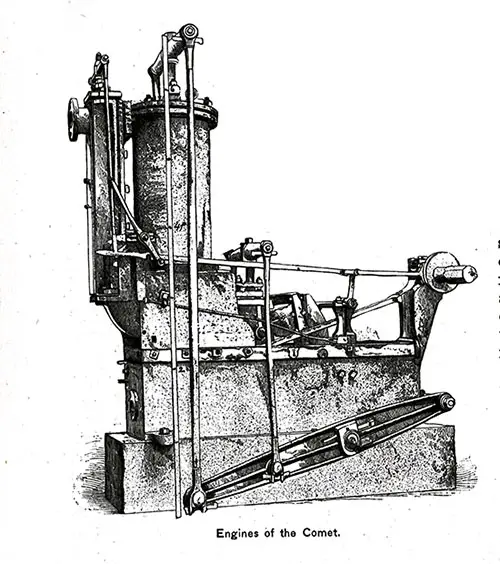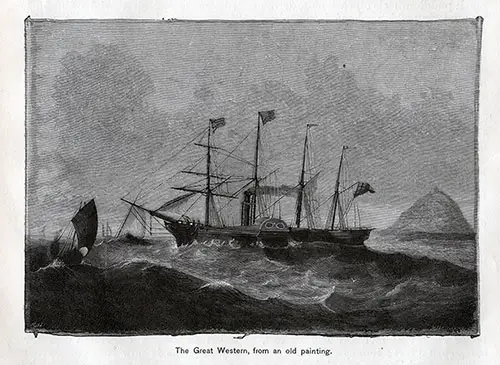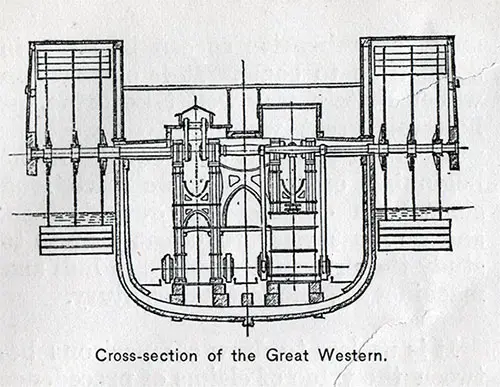Introduction - Development of the Steamship - 1887
THE DEVELOPMENT OF THE STEAMSHIP, AND THE LIVERPOOL EXHIBITION OF 1886.
By Commander F. E. Chadwick, U. S. Navy.
It is a wonderful fact in the swift expansion of mechanical knowledge and appliances of the last hundred years that while for unknown ages the wind was the only propelling force used for purposes of navigation, apart from the rude application of power through oars worked by men, the whole scheme of steam transport has grown, practically, to its present wonderful perfection within the lifetime of men yet living.
Of course, the idea, as is that of all great inventions, was one of slow growth. It cropped up at various stages through the eighteenth century, and there are faint evidences of groupings in this direction in the latter part of the seventeenth; but these latter were not much more definite than the embodiment of the idea of the telegraph in Puck's girdle round the earth, and the evidence that men really thought of propelling boats by steam is very meager until we come to the pamphlet written by Jonathan Hulls, in 1737, in which he gave utterance to a very clear and distinct idea in the matter.
It struggled through a very backward infancy of fifty years and more, certain memorable names appearing now and then to help it along, as that of Watt (without whose improvements in the steam-engine it must still have remained in swaddling-clothes), Fitch, De Jouffroy, Rumsey, Symington, and finally Fulton, who, however much he may have learned from his predecessors, has unquestionably the credit of putting afloat the first commercially successful steamboat.
He is thus worthy of all the honor accorded him : much of it came too late, as he died at the comparatively early age of fifty, after passing through the harassments which seem naturally to lie in the path of the innovator.
The International Exhibition at Liverpool - 1886
A graphic history of the wonderful changes wrought in this great factor of the world's progress was set forth during the summer of 1886, at the International Exhibition at Liverpool, where, by model and drawing, the various steps were made more completely visible and tangible than, perhaps, ever before.
True, the relics of the earlier phases of the steamship age, when its believers were but few and generally of small account, were sparse, but the exhibits of later models, from the date of the inception of transatlantic traffic, preparations for which were begun in earnest by laying down the steamship Great Western exactly fifty years ago, were frequent enough, and the whole of the steps in the development of the means of ocean traffic from then till now are sufficiently well shown.
The exhibition, of course, did not confine itself to the steam era alone. It even had a model of an Egyptian vessel, which was exhibited by the Liverpool Library Society, as taken from Thebes, and estimated to date about 1,500 years B.C., and which Moses himself might thus have seen.
It was a long stretch, however, to the next in date, as no others antedated 1700 A.D. There were many of the handsome and dignified eighteenth-century men-of-war, built at a time when men began to preserve a record of their work in the miniature ships which are now esteemed an essential addition to almost every vessel of importance put afloat.

Illustration 1: Engines of the Comet.
Firms now exist whose only business it is to make the various minute fittings—the ports, chains, anchors, Engines of the Comet, blocks, etc.—of the Lilliputian craft, so that every detail of the original is given with an exact verisimilitude in very often most beautiful and elaborate work.
It would have been very interesting had the early struggles of the steamboat been thus illustrated in extensor, but there is nothing of its concrete history earlier than a small model of the original Comet, built by Henry Bell, at Glasgow, in 1812, and so named because of the extraordinary comet of that year, and the engines of her successor, built in 1820. These recall, however, the vessel which was the first steamer engaged in passenger traffic in Europe, and are thus worthy of honor.
In looking over the beautiful array of models which thus represented almost every stage of progress in British steamship building, from the Comet onward, one cannot help regretting that an effort had not been made by our Government to bring together models, of which there must be some, at least, available, illustrative of our earlier practice, particularly as there is much in it peculiar to us, and which would have been most interesting to the great public which visited the exhibition.
Models of the Clermont; of the Stevens experimental screw boat; a later Mississippi steamer; the Savannah—the first vessel using steam which ever crossed the Atlantic; the Washington, the pioneer of regular transatlantic steam traffic under our flag; the Adriatic; the Hudson River and great Sound steamers of to-clay, would, apart from any warship models of interest which could have been sent, have made a most interesting and attractive collection.
The only things, however, which were visible were the drawings of a New York ferry-boat (the type of which, by the way, we owe to Fulton), so placed as to be scarcely discoverable. These boats are so typical, so different from anything found in Europe, and so interesting to any student of steam ferriage, that a complete model of the boat and its ferry slip would have been a most satisfactory addition.
Ships, both for war and for peaceful pursuits, of almost every European type were present, with the exception of the great armor-clads of France; but the examples I have just mentioned were certainly needed to round out the exhibition to a complete show of the varieties employed in passenger traffic. It must be remembered that the steamboat had in its earlier days a much greater extension in America than elsewhere.
Our great rivers were an especially attractive field for its use. The Mississippi had but lately come under our control, and the beginning of the great tide of Western emigration and exploration was almost coincident with the steamboat's advent, so that through these favoring conditions it had a much more rapid growth among us than elsewhere.
The display, however, of British models was as complete as it could well be made. Private owners and builders, the Admiralty, and Lloyds' Registry, united to make the collection a very complete and perfect one. Of continental European exhibits, that of the Italian Government, which sent a very splendid collection of models of its great war-ships, was the most important.
Associated with it was the exhibit of the Fratelli Orlando of Leghorn who have done much of both the public and private building of Italy. The only French exhibit was that of the Bureau Veritas, which followed the example of its English rival, Lloyds, in making a very striking and instructive show.

Illustration 2: The Great Western, from an old painting.
The only exhibits of modern warships were those of England and Italy, unless we except the numerous vessels built for foreign powers by English builders. The remainder of the display was chiefly connected with the strife of commerce, and in this it is likely to remain as complete and comprehensive as can be made in some time to come.
It is one also in which Britain may well take pride, as, however great we ourselves were as pioneers or as more than equals in the beginning of the race, we have long since been distanced by our kinsmen; and we must refer to Great Britain to study the principal changes in hull and machinery of the last half-century.
It is useless to draw comparisons between the value of claims of precedence in the history of steam navigation. The fact that Fulton's efforts finally started the world to building steamboats is indisputable. All preceding cases were simply sporadic, and had none of the contagious power possessed by the experiments on the Hudson.
Fulton himself had already built six steamboats before one was built elsewhere than in America. His boats, too, from the beginning were of practical value, and not small experiments, the Clermont herself being 136 feet long, 18 feet broad, 7 feet deep, of 160 tons; and the diameter of her wheels was 15 feet.

Cross-section of the Great Western.
In 1809 the first steamboat, the Accommodation, was seen on the St. Lawrence, and in 1811 the first (built at Pittsburgh) appeared on the Mississippi. A year after this the Comet, already alluded to, was put upon the Clyde by Henry Bell.
She was only 40 feet long on the keel, and 14 broad, with 2 small paddle-wheels on each side, driven by a gearing which geared into a wheel on the axle of each set of paddle-wheels. Her original engines are still in existence, and are deposited in the Museum at South Kensington, where they were set up by the same engineer (Mr. John Robertson) who placed them in the Comet.
Fulton also has the honor of being the first to design and build a war steamer, which for her time was a most remarkable production, and by far the largest steam vessel built before 1838. She was a fitting monument to the genius of the man who unfortunately did not live to see her completion and successful trials.
The Demologos, or Fulton the First, was laid down June 20, 1814, and launched October 29th of the same year. " Her dimensions were : length, 150 feet; breadth, 56 feet; depth, 20 feet; water-wheel, 16 feet diameter, length of bucket 14 feet, dip 4 feet; engine, 48-inch cylinder, 5 feet stroke; boiler length 22 feet, breadth 12 feet, and depth 8 feet; tonnage, 2,475."
The commissioners appointed to examine her say in their report :
" She is a structure resting upon two boats, keels separated from end to end by a canal 15 feet wide and 66 feet long. One boat contains the caldrons of copper to prepare her steam. The vast cylinder of iron, with its piston, levers, and wheels, occupies a part of its fellow; the great water-wheel revolves in the space between them; the main or gun deck supporting her armament is protected by a bulwark four feet ten inches thick of solid timber. This is pierced by 30 port-holes, to enable as many 32-pounders to fire red-hot balls. . . . "
"She is rigged with 2 short masts, each of which supports a large lateen yard and sails. She has 2 bowsprits and jibs, and 4 rudders, 2 at each extremity of the boat, so that she can be steered with either end foremost. Her machinery is calculated for the addition of an engine which will discharge an immense column of water, which it is intended to throw upon the decks and through the ports of an enemy." She was also intended to carry 4 100-pounders."
She made her first trial on June 1, 1815, and on the Fourth of July she steamed outside of Sandy Hook and back, a distance of 53 miles, in 8 hours and 20 minutes. She was then supposedly light, as it is stated that she was again tried September 11, 1815, with 26 of her guns on board, and ammunition and stores to bring her down to nearly 11 feet draught. She steamed from 44 to 5 miles an hour, Fulton having only promised 3, and may certainly be considered to have been a success. She was never commissioned, but was used as a receiving ship at New York until June 4, 1829, when she accidentally blew up.
